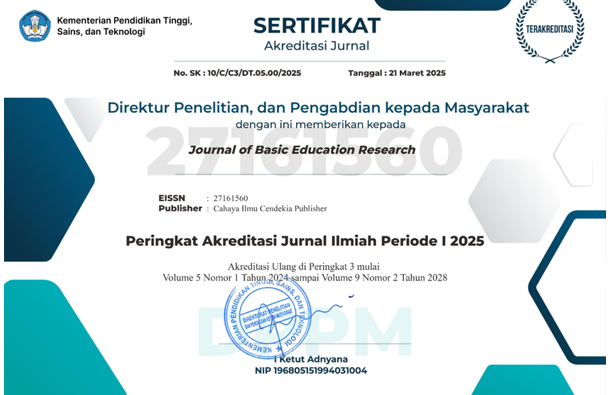Effectiveness of Gamification-Based Learning Application to Prevent Bullying Behavior in Elementary School
Abstract
Purpose of the study: The purpose of this study was to assess the effectiveness of a gamification-based learning application in improving elementary school students' understanding and awareness of bullying prevention
Methodology: A quantitative method using a quasi-experimental one-group pretest and posttest design was used. The study included 49 fifth-grade students from an elementary school in Malang. Data was gathered through pretest and posttest tools consisting of 25 questions. The pretest was administered before the intervention and the posttest after. Data analysis used IBM SPSS Statistics version 26, including normality tests, paired sample t-tests, and N-gain analysis to assess statistical significance and effect size.
Main Findings: The results indicate that there was a significant improvement in students' understanding following the intervention. The average pretest score was 52.33, rising to 87.51 in the posttest. The paired sample t-test produced a significance value of p < 0.001, indicating strong effectiveness. Furthermore, the N-gain analysis yielded a value of 0.71 indicated high effectiveness. Therefore, the gamification-based application serves as a valuable educational tool for increasing bullying prevention awareness in elementary schools.
Novelty/Originality of this study: This study provides the first empirical evidence for the effectiveness of a gamification-based mobile application specifically designed to teach bullying prevention to elementary school students. It bridges a critical research gap by quantitatively validating how tailored game mechanics (combines quizzes, mini-games, and role-playing scenarios) enhance comprehension of bullying dynamics and addressing the absence of methodologically rigorous evaluations in context-specific gamified learning for child safety education.
References
M. Y. Nugraha and M. Sirozi, “Strategi tindakan kekerasan dan bullying di sekolah: bentuk, pelaku dan pencegahannya,” Jurnal Pendidikan dan Teknologi Indonesia (JPTI), vol. 5, no. 3, pp. 881–885, 2025, doi: 10.52436/1.jpti.787.
V. U. Hasibuan, W. Lestari, F. Yani, and S. M. Lova, “Edukasi bullying pada anak sekolah dasar dalam pendidikan multikultural,” Journal Of Human And Education (JAHE), vol. 3, no. 4, pp. 117–125, Dec. 2023, doi: 10.31004/jh.v3i4.430.
N. D. Lestari et al., “Sosialisasi penindasan anak di SDN 198 Palembang,” Nusantara Journal of Multidisciplinary Science, vol. 1, no. 5, pp. 1141–1148, 2023, doi: doi.org/10.60076/njms.
F. Abdillah, “Dampak bullying di sekolah dasar dan pencegahannya,” EDUCARE: Jurnal Pendidikan dan Kesehatan, vol. 2, no. 1, pp. 102–108, Dec. 2024, doi: 10.70437/jedu.v2i1.19.
E. D. Hawke and D. Whitehead, “The behavioral ecological model as a framework for school-based anti-bullying health promotion interventions,” The Journal of School Nursing, vol. 25, no. 3, pp. 195–204, Jun. 2009, doi: 10.1177/1059840509334364.
S. Ernawati, I. Irawan, M. Fauzi, ST Sarah A, and A. Mariam F, “Penyuluhan stop bullying dan kekerasan seksual pada anak usia dini di sekolah dasar negeri panda,” ADM : Jurnal Abdi Dosen dan Mahasiswa, vol. 1, no. 3, pp. 243–248, Nov. 2023, doi: 10.61930/jurnaladm.v1i3.337.
A. Sukawati, D. A. Muiz Lidinillah, and N. Ganda, “Fenomena bullying berkelompok di sekolah dasar,” PEDADIDAKTIKA: Jurnal Ilmiah Pendidikan Guru Sekolah Dasar, vol. 8, no. 2, pp. 354–363, Jun. 2021, doi: 10.17509/pedadidaktika.v8i2.35344.
R. Emi, S. Syahrial, and V. A. Hardi, “Hubungan perilaku bullying dengan kemampuan interaksi sosial siswa kelas V SD negeri 37 Pekanbaru,” Indonesian Research Journal On Education, vol. 1, no. 1, pp. 1–10, Jan. 2021, doi: 10.31004/irje.v1i1.1.
R. Candrawati and A. Setyawan, “Analisis perilaku bullying terhadap motivasi belajar siswa sekolah dasar,” PANDU : Jurnal Pendidikan Anak dan Pendidikan Umum, vol. 1, no. 2, pp. 64–68, May 2023, doi: 10.59966/pandu.v1i2.127.
S. A. Visty, “Dampak bullying terhadap perilaku remaja masa kini,” Jurnal Intervensi Sosial dan Pembangunan (JISP), vol. 2, no. 1, pp. 50–58, Jan. 2021, doi: 10.30596/jisp.v2i1.3976.
D. Maulana, “3.800 Kasus Bullying di Indonesia, KPAI: Tiap Tahun Terus Naik,” selalu.id. Accessed: Aug. 01, 2025. Available: https://selalu.id/news-8162-3800-kasus-bullying-di-indonesia-kpai-tiap-tahun-terus-naik
T. Wulandari, “Kekerasan di sekolah hingga pesantren 2024, JPPI: Terbanyak kekerasan seksual,” detikedu. Accessed: Jun. 20, 2025. [Online]. Available: https://www.detik.com/edu/sekolah/d-7705729/kekerasan-di-sekolah-hingga-pesantren-2024-jppi-terbanyak-kekerasan-seksual
Antara, “FSGI sebut korban kekerasan di lingkungan pendidikan mencapai 144 peserta didik,” Media Indonesia. Accessed: Jun. 20, 2025. [Online]. Available: https://mediaindonesia.com/humaniora/706331/fsgi-sebut-korban-kekerasan-di-lingkungan-pendidikan-mencapai-144-peserta-didik
OECD, “Nurturing social and emotional learning across the globe,” OECD, Oct. 2024. doi: 10.1787/32b647d0-en.
D. Octavia, M. Puspita, and L. S. Yan, “Fenomena perilaku bullying pada anak di tingkat sekolah dasar,” Riset Informasi Kesehatan, vol. 9, no. 1, pp. 43–50, Jun. 2020, doi: 10.30644/rik.v9i1.273.
D. Ariani, “Gamifikasi untuk pembelajaran,” Jurnal Pembelajaran Inovatif, vol. 3, no. 2, pp. 144–149, Nov. 2020, doi: 10.21009/JPI.032.09.
I. G. G. S. Putra, I. W. Widana, and I. G. A. G. Wiadnyana, “Pengembangan aplikasi spacemath berbasis gamifikasi sebagai media pembelajaran matematika tingkat SMP,” Emasains : Jurnal Edukasi Matematika dan Sains, vol. 14, no. 1, pp. 115–124, Mar. 2025, doi: 10.59672/emasains.v14i1.3892.
M. Mohammed, A. Fatemah, and L. Hassan, “Effects of gamification on motivations of elementary school students: An action research field experiment,” Simul Gaming, vol. 55, no. 4, pp. 600–636, 2024, doi: 10.1177/10468781241237389.
Z. Zainuddin, S. K. W. Chu, M. Shujahat, and C. J. Perera, “The impact of gamification on learning and instruction: A systematic review of empirical evidence,” Educ Res Rev, vol. 30, p. 100326, Jun. 2020, doi: 10.1016/j.edurev.2020.100326.
A. Harum, F. Aulia, and M. Anas, “Pengembangan aplikasi bimbingan dan konseling ‘circle’ berbasis android sebagai self development untuk korban bullying,” Ghaidan: Jurnal Bimbingan Konseling Islam dan Kemasyarakatan, vol. 7, no. 1, pp. 55–64, Jan. 1970, doi: 10.19109/ghaidan.v7i1.17160.
J. R. Lubis, “Efektivitas Game edukasi stop bulliying dalam meningkatkan kesadaran anti-bulliying pada anak SD menggunakan construct 2 dan metode MDLC,” Jurnal SANTI - Sistem Informasi dan Teknik Informasi, vol. 4, no. 2, pp. 54–60, 2024, doi: 10.58794/santi.v4i2.777.
J. Shao, S. N. Abdul Rabu, and C. Chen, “Gamified interactive e-books for bullying prevention: enhancing knowledge and motivation in chinese primary schools,” Front Psychol, vol. 16, Feb. 2025, doi: 10.3389/fpsyg.2025.1509549.
Sugiyono, Metode Penelitian Kuantitatif, Kualitatif dan R&D, 2nd ed. Bandung: ALFABETA, 2023.
B. C. Ngongoloy and M. A. I. Pakereng, “Penerapan metode linear regression dan correlation pearson dalam menganalisis pengaruh kualitas pembelajaran online terhadap prestasi akademik,” Progresif: Jurnal Ilmiah Komputer, vol. 19, no. 2, pp. 844–857, 2023, doi: 10.35889/progresif.v19i2.1529.
A. Maulana, “Analisis validtas, reliabilitas, dan kelayakan instrumen penilaian rasa percaya diri siswa,” Jurnal Kualita Pendidikan, vol. 3, no. 3, pp. 133–139, Dec. 2022, doi: 10.51651/jkp.v3i3.331.
A. Field, Discovering statistics using SPSS 3rd Edition, 3rd ed. SAGE, 2009.
D. E. Meltzer, “The relationship between mathematics preparation and conceptual learning gains in physics: A possible ‘hidden variable’ in diagnostic pretest scores,” Am J Phys, vol. 70, no. 12, pp. 1259–1268, 2002, doi: 10.1119/1.1514215.
Sugiyono, Metode Penelitian Kuantitatif, Kualitatif dan R&D. Bandung: ALFABETA, 2017.
A. M. Suparman, Panduan Para Pengajar dan Inovator Pendidikan : Desain Instruksional Modern. Jakarta: Erlangga, 2012.
Y. Yulianti, M. Muslimah, and A. Abdullah, “Gamifikasi sebagai pendekatan inovatif untuk peningkatan pemahaman siswa,” Jurnal Intelektualita: Keislaman, Sosial, dan Sains, vol. 13, no. 2, pp. 265–274, 2024, doi: 10.19109/intelektualita.13i2.24904.
A. Muzanni, B. S. Kartiani, R. Sudarwo, K. Anam, and M. Handayani, “Efektivitas penggunaan media pembelajaran berbasis gamifikasi untuk meningkatkan pemahaman konsep IPA siswa SD,” PeDaPAUD: Jurnal Pendidikan Dasar dan PAUD, vol. 4, pp. 18–28, 2025, doi: https://doi.org/10.47165/pedapaud.v4i1%20April.
M. A. Sultan, M. Maryam, and W. Krismanto, “Android-based role-playing educational games to support strengthening children’s character education in elementary school,” Jurnal Penelitian dan Pengembangan Pendidikan, vol. 9, no. 1, pp. 102–113, Apr. 2025, doi: 10.23887/jppp.v9i1.82185.
I. Irnawati, M. Muthoharoh, S. L. Siti, F. Khasanah, and D. Y. Noviayana, “Efektivitas game sebagai media pencegahan bullying dan kekerasan seksual pada anak,” Legal Journal Research, vol. 1, no. 1, pp. 14–21, 2025, [Online]. Available: https://jurnal.permataedukasi.com/
N. Heryani, A. Asmuni, and A. F. D. Nasution, “Pengembangan aplikasi strategi pencegahan perilaku perundungan (bullying) pada sekolah dasar di kota Jambi,” Jurnal Akademika Baiturrahim Jambi, vol. 9, no. 2, p. 190, Sep. 2020, doi: 10.36565/jab.v9i2.213.
S. A. P. D. Dewi, A. Riyono, and G. Gudnanto, “Pengembangan media bimbingan klasikal berbasis aplikasi lectora inspire untuk mengatasi perilaku bullying di SMP 1 kaliwungu kudus,” P2M STKIP Siliwangi, vol. 10, no. 2, pp. 65–72, 2023, doi: 10.22460/p2m.v10i2.3767.
C. M. Lisabe, N. Wahdi, W. Puspitasari, V. N. Van Harling, and A. Santoso, “Workshop aplikasi mobile safeclick sebagai edukasi interaktif pencegahan cyberbullying untuk remaja berbasis game edukasi,” JIPITI: Jurnal Pengabdian kepada Masyarakat, vol. 2, no. 2, pp. 137–142, 2025
R. S. A. Pamungkas and S. Sutama, “Minimalizing bullying at SD negeri karangwaru 2 sragen by stop bullying application,” in Proceedings of the International Conference on Learning and Advanced Education (ICOLAE 2022), 2023, pp. 1926–1935. doi: 10.2991/978-2-38476-086-2_154.
R. A. Sekarjene and N. Setyasto, “Pengembangan media komik digital berbasis karakter untuk mengurangi perilaku perundungan (bullying) pada siswa kelas V SD islam Al-Azhar 29,” JIIP - Jurnal Ilmiah Ilmu Pendidikan, vol. 6, no. 6, pp. 4376–4386, Jun. 2023, doi: 10.54371/jiip.v6i6.2028.
R. Fajriati, H. Herawati, F. Asyura, and P. Ilhamsyah, “Edukasi bullying menggunakan media audio visual pada siswa sd kelas vi mis hafizh cendekia banda aceh,” JOURNAL OF EDUCATION SCIENCE, vol. 9, no. 1, p. 1, Apr. 2023, doi: 10.33143/jes.v9i1.2848.
N. H. Makkatenni, A. T. Bamba, R. S. Tandiallo, N. Nurmila, and N. Ariqah, “Molly polly: Permainan berbasis media pembelajaran untuk mengedukasi anti perilaku perundungan,” JURNAL PSIKOLOGI INSIGHT, vol. 5, no. 2, pp. 116–129, Sep. 2023, doi: 10.17509/insight.v5i2.62765.
Copyright (c) 2025 Noer Intan Oktavia, Sutarno, Khusnul Khotimah

This work is licensed under a Creative Commons Attribution 4.0 International License.
Authors who publish with this journal agree to the following terms:
- Authors retain copyright and acknowledge that the Journal of Basic Education Research is the first publisher licensed under a Creative Commons Attribution 4.0 International License.
- Authors are able to enter into separate, additional contractual arrangements for the non-exclusive distribution of the journal's published version of the work (e.g., post it to an institutional repository or publish it in a book), with an acknowledgment of its initial publication in this journal.
- Authors are permitted and encouraged to post their work online (e.g., in institutional repositories or on their website) prior to and during the submission process, as it can lead to productive exchanges and earlier and greater citation of published work.





.png)


.png)
.png)


















